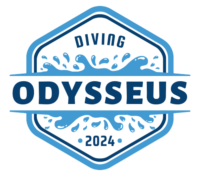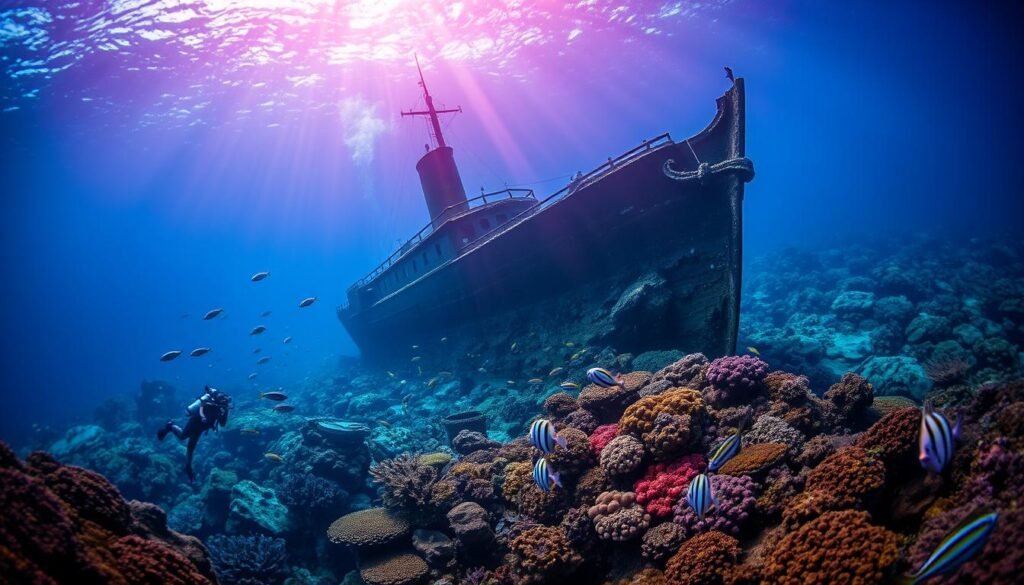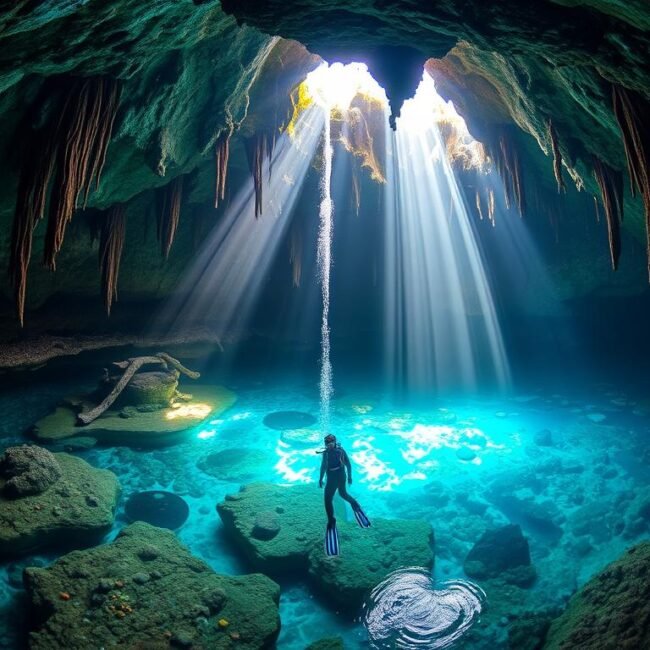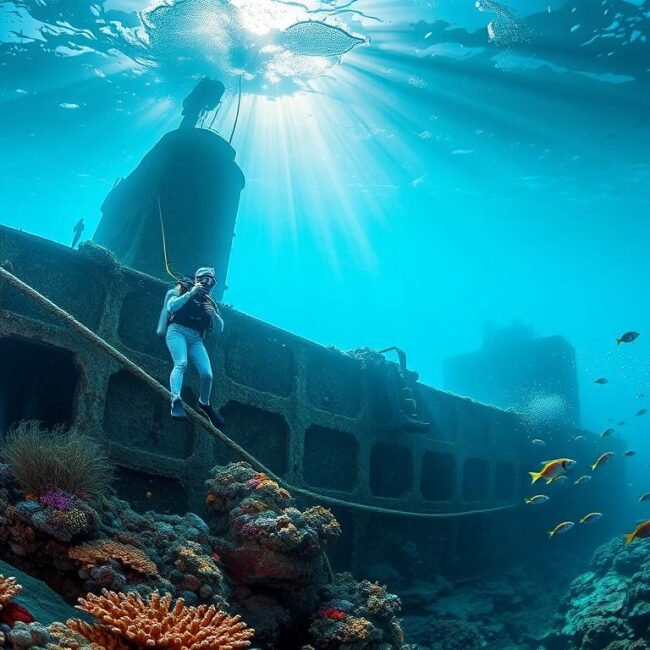“Dude, did you know that beneath the surface of some of the world’s most gorgeous waters lie sunken ships that are basically time capsules?” I remember the first time I stumbled upon this fact—my mind was totally blown! I thought divers just looked at coral reefs and tropical fish. But, there’s a whole other world down there.
Massive wrecks filled with history, mystery, and marine life are waiting. Exploring shipwrecks is like diving into an underwater museum. It’s not just seeing a big boat on the seafloor. It’s about connecting with past stories while surrounded by fish.
Some wrecks are easy for newbies, while others need serious diving skills. Either way, each site is a mix of history, marine life, and cool photo ops. Let’s dive into some of the world’s best wreck diving sites , sharing stories, tips, and lessons learned.
So, strap on your fins, buddy, because we’re about to dive into unforgettable underwater adventures!
Below is a chart summarizing each shipwreck mentioned, along with a one-sentence evaluation for each:
| Shipwreck | Location | Key Highlights | Approx. Depth Range | One-Sentence Evaluation |
|---|---|---|---|---|
| SS Thistlegorm | Red Sea, Egypt | WWII British merchant ship with cargo (motorcycles, trucks), rich marine life | 16–33 meters | “A historically rich WWII wreck that’s both visually striking and challenging enough for intermediate divers.” |
| SS Yongala | Great Barrier Reef, Australia | Luxury passenger ship, abundant sea life (sea snakes, manta rays), well-preserved wreck | 14–28 meters | “A vibrant underwater haven where abundant marine life and a storied ship’s legacy beautifully intersect.” |
| Fujikawa Maru | Chuuk Lagoon, Micronesia | WWII Japanese cargo ship, aircraft parts, abundant coral and fish | 9–33 meters | “A WWII time capsule blending history and marine ecosystems to create a surreal underwater experience.” |
| USS President Coolidge | Vanuatu | Former luxury liner turned troopship, large structure, ‘The Lady’ statue, military artifacts | 20–70 meters | “A massive, deep wreck that offers experienced divers a haunting glimpse of WWII history beneath the waves.” |
| MS Zenobia | Larnaca, Cyprus | Swedish ferry with over 100 intact vehicles, lies on its side, top-tier wreck dive site | 16–42 meters | “An enormous artificial reef packed with vehicles and intriguing sections for both intermediate and advanced divers.” |
| Hilma Hooker | Bonaire, Caribbean Netherlands | Intentionally sunk, once used for smuggling, easy shore access, great for beginners | 18–30 meters | “A laid-back, shore-accessible wreck perfect for new wreck divers looking for a no-stress introduction.” |
| RMS Rhone | British Virgin Islands | Royal Mail Ship, lost in a hurricane, featured in a film, coral-encrusted and teeming with fish | 9–24 meters | “A storied wreck that’s shallow enough for longer bottom time and brimming with colorful marine life.” |
| SS Carnatic | Red Sea, Egypt | 19th-century British steamship, partly intact structure, known for resident glassfish | 20–27 meters | “A classic, older wreck that gracefully merges Victorian-era ship lines with modern marine life.” |
| Umbria | Wingate Reef, Sudan | Italian cargo ship scuttled before WWII, intact cargo of Fiat cars and munitions | 5–38 meters | “A remarkably preserved historical relic where nature and cargo from another era coexist beautifully.” |
| USS Oriskany | Florida, USA | Intentionally sunk aircraft carrier, known as the “Great Carrier Reef,” advanced/technical dive | 24–61 meters | “A colossal artificial reef turning a proud warship into an awe-inspiring, marine-rich structure for skilled divers.” |
SS Thistlegorm, Red Sea, Egypt
The Story Behind the Wreck
When I first heard about the SS Thistlegorm, I couldn’t believe it. It’s a World War II-era British ship at the bottom of the Red Sea. Sunk in 1941, it carried motorcycles, trucks, and wartime supplies. I thought, “Wait, seriously, motorcycles underwater?” It sounded like a dream.
This ship was on a mission, part of those crazy WWII logistics runs. Sadly, it was bombed by German forces. Now, it’s a diver’s paradise.
Diving Conditions and Depth
The Thistlegorm is for intermediate to advanced divers, at 16 to 33 meters deep. If you’re new to diving, start somewhere else. The current was a bit tricky, but nothing insane.
My buddy and I had a decent amount of dives. We still found ourselves gripping the line during descent. The visibility was great, making it feel like we’d discovered an underwater city.
Marine Life and Underwater Scenery
Nature has reclaimed this piece of history. Everywhere, you see marine life: barracudas, lionfish, and huge schools of fish. The hull and cargo bays are now an ecosystem.
It’s like the sea said, “This ship is mine now, thanks!” I got a kick out of finding coral-encrusted motorcycles. It looked like a surreal art installation. One time, I nearly forgot to check my depth gauge. Lesson learned: the Thistlegorm can distract even the best of us!
My Personal Tips and Anecdotes
Before diving, get a good briefing from your dive operator. They’ll show you the best route and warn you about currents. Trust me, it’s worth listening closely.
Stick together and communicate with your buddy using clear hand signals. On my first attempt, I left my buddy behind. Oops, big no-no.
If you’re into photography, bring your camera and maybe a wide-angle lens. The scale of this wreck is impressive. Just remember, you can’t spend forever down there, so plan your bottom time and gas consumption carefully. Feeling a bit nervous is totally normal, especially if you haven’t done many wreck dives before. But trust me, it’s worth pushing past that initial hesitation.
Wrapping Up the Experience
Diving the SS Thistlegorm felt like time travel and floating in another world. It’s a dive that challenges you and offers a taste of history. I surfaced with a huge grin, amazed by the experience. Wreck diving, especially at SS Thistlegorm, is truly magical.
READ MORE: Best Red Sea Diving Spots: Underwater Paradise Awaits
“The thrill of exploring a shipwreck is unparalleled, as each dive unveils a new chapter in the vessel’s remarkable history.”
SS Yongala, Great Barrier Reef, Australia
A Historic Luxury Liner Turned Underwater Haven
The SS Yongala was a luxury ship that sailed Australia’s coast. A cyclone in 1911 sank it to the ocean floor. Its story is like a historical drama, with tales of fancy passengers.
Depth and Ease of Access
The Yongala lies at 14 to 28 meters deep, making it both accessible and challenging. You need good buoyancy skills to dive it. Descending onto the wreck was thrilling, with clear water and a ship silhouette appearing slowly.
Marine Life Explosion
The Yongala is famous for its marine life. You’ll see sea snakes, massive groupers, and manta rays. It’s like an underwater party with incredible guests. A sea snake encounter was thrilling, but they’re not dangerous.
Personal Dive Tips and Lessons Learned
Be aware of strong currents at the wreck. They’re not too strong, but you need good fin technique. I got lost once because I was too busy watching a grouper. Always keep track of your position and have a plan with your buddy.
Also, bring a torch to explore the wreck’s corners. You might find hidden eels or sleeping turtles. Remember, the wreck is protected, so don’t touch or remove anything. Just enjoy the view and take photos.
The Yongala’s Lasting Impression
After diving the Yongala, I floated on my back, thinking about its past. The ship’s story and the marine life create a stunning contrast. The SS Yongala is a dive that’s full of life and history. It left me with awe and respect for nature’s power.
READ MORE: Experience Great Barrier Reef Diving in Australia
Fujikawa Maru, Chuuk Lagoon, Micronesia
World War II History Beneath the Waves
The Fujikawa Maru is like a forgotten scrapbook of World War II, now hidden under the calm waters of Chuuk Lagoon. Sunk during Operation Hailstone in 1944—a major U.S. attack on the Japanese fleet—this cargo ship is brimming with relics from a bygone era. I remember reading about it and thinking, “Wow, this is like diving into a historical documentary, except I’m actually there!” If you’ve ever wanted to feel like Indiana Jones in a wetsuit, this is your shot.
Dive Profile and Conditions
The wreck rests upright at depths from about 9 to 33 meters. So you can start shallow at the top and then go deeper if you’re comfortable. The first time I dove the Fujikawa Maru, I couldn’t help but gasp at the clarity. Visibility can be pretty darn good, though it can vary.
There’s something almost eerie about gliding over the deck, imagining the chaos that led to this ship’s sinking. You’ll need decent buoyancy control, though, especially if you want to peek inside the cargo holds without kicking up silt and reducing visibility.
Relics and Marine Life
Talk about cool stuff: inside the Fujikawa Maru, you’ll find fighter aircraft parts, old ammunition, and other war relics. On one dive, I remember shining my torch into a hold and seeing the outlines of old Zero fighter planes—it felt like a scene from a time capsule. Over the years, coral and marine life have claimed these relics as their own, turning steel beams into vibrant underwater gardens.
Everywhere you look, fish dart in and out of the wreck’s structure, and coral encrustations give the metal surfaces a soft, living texture. I spotted clownfish peeking around an old engine, like they were guarding it. Surreal doesn’t even begin to describe it.
Tips for Exploring the Wreck Safely
If you’re new to wreck diving, start with easier sites before the Fujikawa Maru. The ship has dark, enclosed areas. A good torch and careful approach are key.
On my first dive, I got too excited and swam fast into a cargo hold. This stirred up sediment. Next time, I moved slowly and gently. This way, I didn’t turn the wreck into a snow globe of silt.
Listen to your guide’s briefing. They’ll show you the best routes and iconic spots, like the fighter plane remnants. Don’t forget your camera! But, capturing the wreck’s true scale and atmosphere is tough.
A Dive Into History
Diving the Fujikawa Maru is an adventure that combines history and marine biology. You’ll leave with a deeper respect for history and nature’s power. I felt humbled and enthralled after diving.
If you want to dive beyond ordinary reef dives, dive the Fujikawa Maru. It’s a living piece of WWII history. You won’t regret it.
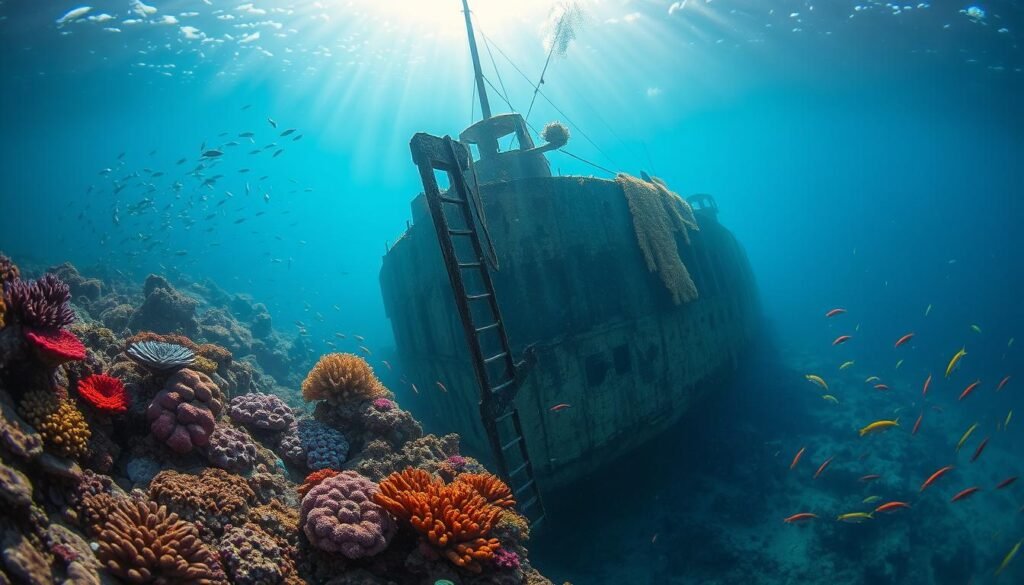
“The SS Thistlegorm is one of the most remarkable and well-preserved wreck dives in the world. Its intact cargo and diverse marine life make it a true treasure trove for adventurous divers.
USS President Coolidge, Vanuatu
From Luxury Liner to Troop Transport
The USS President Coolidge wasn’t always a warship. Initially, it was a swanky luxury liner, ferrying wealthy passengers in comfort and style. Then came World War II, and it got converted into a troopship. In 1942, while trying to avoid friendly mines, it tragically sank near Espiritu Santo in Vanuatu. Hearing this backstory gave me chills. It’s like one of those crazy twists in a movie you never see coming. Now it’s a massive underwater playground for divers who love exploring big wrecks.
Depth and Experience Level
This dive is not for the faint of heart. Depths range from 20 to 70 meters, offering a variety of experiences. Beginners should stick to shallower areas, while advanced divers can explore deeper.
I was amazed by the Coolidge’s size on my first dive. It’s massive, with so much to see. Make sure you control your buoyancy and gas well. A sudden “out of air” moment in the dark is not what you want.
Must-See Attractions: “The Lady” and Artifacts
The Coolidge is home to “The Lady,” a statue from the ship’s luxurious past. Military artifacts like rifles and helmets are scattered around. Seeing The Lady up close is a haunting yet awe-inspiring experience.
Tips for a Safe and Enjoyable Dive
Consider hiring a local guide for the USS President Coolidge. It’s easy to get lost in the wreck’s corridors. A guide can show you the best paths and highlight interesting spots.
Bring a torch for dark areas and use Nitrox if you can. It makes the dive more comfortable. Don’t dive too deep too fast. Start slow and build up your comfort level.
Reflections on a Grand Wreck
Diving the Coolidge is like swimming through history. It’s an enriching experience. The ship’s story is a reminder of the hopes and fears of those who sailed on it. If you’re up for a challenge, the Coolidge awaits.
MS Zenobia, Larnaca, Cyprus
A Modern Wreck With a Surprising Story
The MS Zenobia sank on its first voyage in 1980. It’s a story of a ship that never got to prove itself. Now, divers from around the world visit Cyprus to see it.
Dive Profile and Conditions
The Zenobia lies at 16 to 42 meters, appealing to many divers. My first dive was unforgettable, with trucks still on the deck. The water is clear, and the climate is mild, making it a comfortable dive site. Just be careful not to get too carried away by curiosity.
Exploring the Vehicles and Interior
The Zenobia is like an underwater parking lot. It has over 100 intact vehicles inside. When you look through openings, it looks like a futuristic junkyard.
On one dive, I saw a row of trucks in the cargo hold. They were covered in growth, like in a sci-fi movie. It’s surreal. Advanced divers can explore deeper parts like the cafeteria and engine room. But, always dive with a guide to avoid getting lost.
My Personal Tips and Wreck Lessons
Buoyancy is crucial here. With many levels, staying neutral is essential. My first dive was shaky because I was too heavy. Adjusting my weights helped me move better.
Carry a good torch for dark areas. A line reel is useful for penetration dives. But, if you’re not trained, stick to the outside for safety.
Take your time while exploring. I stared at a door hinge for a minute, amazed by the coral art. This wreck is a mix of human and marine life.
Rising Up With a Smile
After diving the Zenobia, I felt like I’d seen a museum and a ghost town. The ship’s story and the sea life made it unforgettable. The MS Zenobia is a must-see for any wreck enthusiast. Seeing those sunken trucks is unforgettable.
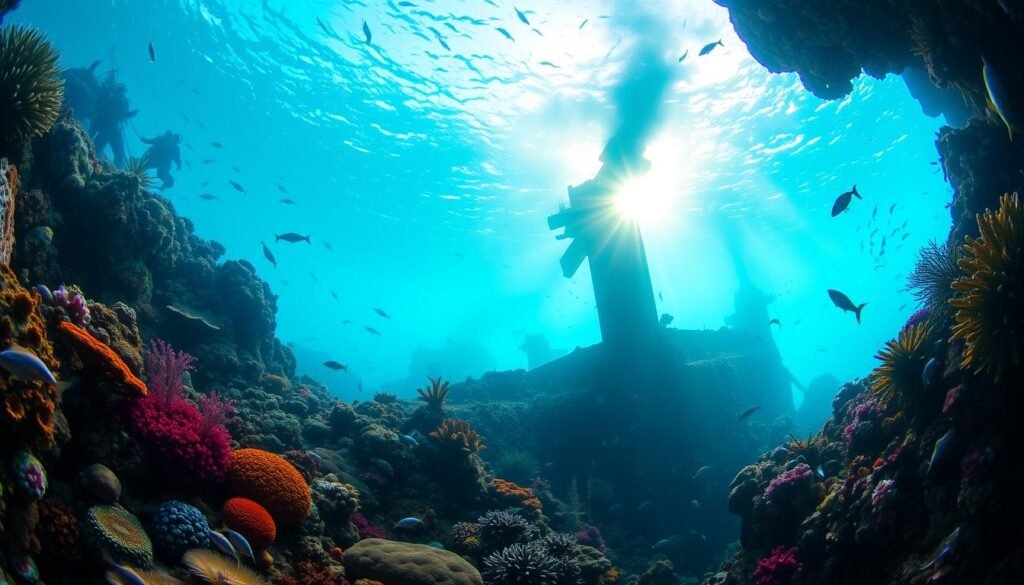
Hilma Hooker, Bonaire, Caribbean Netherlands
From Smuggler to Diver’s Delight
The Hilma Hooker has a fascinating history. It was once a drug smuggler’s ship. In 1984, it was sunk off Bonaire after legal issues and engine problems.
Today, it’s a famous dive site for all levels of divers. I was amazed when I first heard its story. A smuggling ship turned into a coral reef for divers.
Depth and Accessibility
The wreck is easy to reach, sitting at 18 to 30 meters deep. It’s accessible from shore, making it simple for divers. I remember swimming out and seeing the wreck’s shadow.
Marine Life and Conditions
The wreck is teeming with life: tarpon, angelfish, and more. Coral covers the hull, and fish call it home. You might see seahorses too.
The water is clear and warm, making diving relaxed. My first dive was peaceful, with fish dancing around me. It felt like the island’s calm vibes.
Tips for a Chill Dive
The Hilma Hooker can get busy, especially with beginners and intermediate divers. Diving early in the morning is quieter. I had a peaceful dive then, unlike the busy midday dive.
It’s great for beginners because you can explore the outside without going inside. The wreck’s starboard side offers a unique view, like underwater Wonderland.
Returning to the Surface with a Smile
After diving the Hilma Hooker, I felt carefree. It’s welcoming for all divers, beginners or experienced. It shows that even a ship with a past can bring joy.
RMS Rhone, British Virgin Islands
A Royal Mail Ship with a Dramatic End
The RMS Rhone was a grand ship that sank in 1867. A hurricane destroyed it, and it now lies off Salt Island. Exploring its remains is a dive to remember.
Dive Conditions and Structure
The Rhone lies between 9 to 24 meters deep, making it accessible to many divers. It’s famous in the Caribbean and even featured in “The Deep.” I was excited to dive it. The wreck is split into two parts, allowing for thorough exploration.
The shallow depths are perfect for longer dives and better light. It’s great for those without advanced wreck diving skills. Just be careful of the current, which can be strong at times.
Coral Growth and Marine Life
Over time, the Rhone has become a home for corals, sponges, and fish. It looks like a sculpture garden, with nature’s artistry on display. I saw a big green moray eel and schools of fish around the wreck.
The colors are stunning. It feels like swimming through an underwater art gallery. Nature has transformed the ship into a thriving ecosystem.
Personal Tips for Enjoying the Dive
Photography lovers will love this dive. The natural light is excellent, and the marine life is eager to pose. I made the mistake of not checking my camera settings, resulting in overexposed photos. Make sure to double-check before diving.
Try diving at different times for different lighting effects. Take your time to appreciate the details. Your guide might show you hidden treasures like the silver spoon. Remember, touching or removing artifacts is strictly forbidden.
Savoring a Piece of History
Diving the RMS Rhone is like time travel in the Caribbean. You connect with history while enjoying the clear, warm water. I felt enriched and a bit hungry after diving. If you’re in the British Virgin Islands, don’t miss this dive.
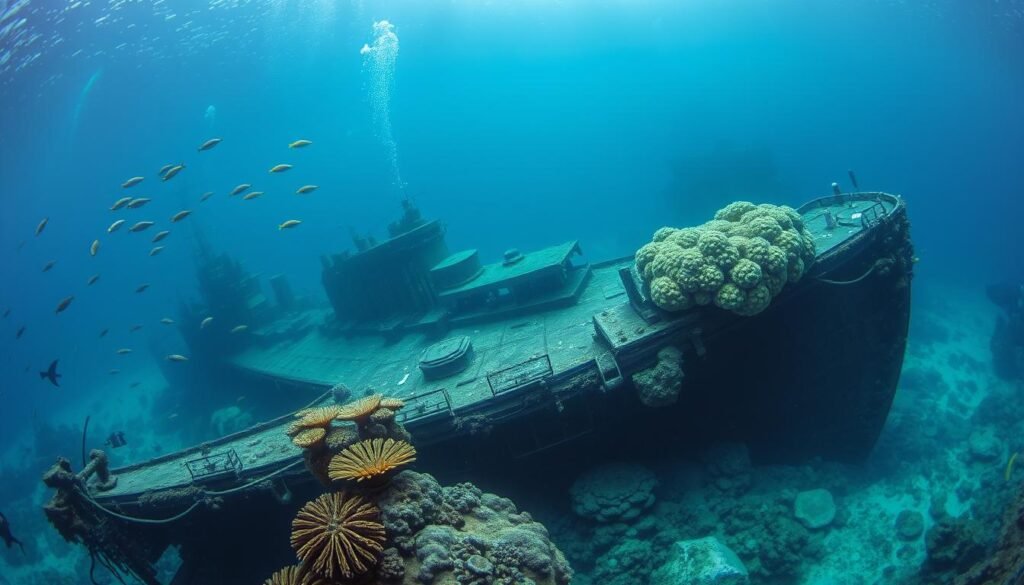
SS Carnatic, Red Sea, Egypt
A British Steamship With an Old-School Vibe
The SS Carnatic is a wreck with character. It sank in 1869 and is now home to corals and fish in the Red Sea. There’s something special about these older ships, like stepping into a Victorian story.
Depth and Suitability
The Carnatic is at 20 to 27 meters, suitable for intermediate divers. The visibility is good, and the current is usually manageable. I was nervous about the currents but felt at ease once I saw the wreck.
The site is easy to navigate, allowing for a relaxing dive. You can spend a lot of time exploring the wreck and its surroundings.
Intact Structure and Glassfish Galore
The Carnatic is special because much of it is still standing. It’s like swimming through a huge, open-air metal frame. The highlight for me was seeing schools of glassfish.
These tiny, shimmering fish moved in harmony, reflecting the light. It was hypnotic. I felt like I was in a shimmering snow globe, but underwater.
If you like exploring wrecks, the Carnatic is worth a visit. You can shine a torch into corners and find hidden life. Just make sure you’re trained and comfortable with overhead environments.
I saw a moray eel peeking out at me. It was a surprise!
Tips for a Great Dive
Take your time. The Carnatic is best appreciated slowly. Hover and watch the fish. I noticed details I missed the first time around.
A good torch is essential for seeing inside. And remember to keep an eye on your depth and air.
Leaving With a Smile
Diving the SS Carnatic felt like seeing history being reclaimed by nature. It’s not the biggest wreck, but it’s charming. If you’re looking for a dive with history, easy conditions, and lots of fish, try the Carnatic.
Umbria, Wingate Reef, Sudan
An Italian Cargo Ship’s Final Stand
The Umbria was an Italian cargo ship scuttled in 1940. The captain sank her near Wingate Reef in Sudan to keep the cargo from the enemy. It’s a rare wreck in great condition.
Dive Profile and Conditions
The wreck is at depths from 5 to 38 meters. You can dive shallow or deeper if you’re certified. Sudan is less crowded than Egypt, making for a peaceful dive.
My first dive on the Umbria felt private. It was just me, my buddy, and a guide exploring a nearly untouched time capsule.
Cargo of Fiats and Munitions
The Umbria still holds a cargo of intact Fiat cars, bombs, and munitions. It’s like finding a secret stash in an old spy movie. Shining my torch into a cargo hold showed bombs neatly stacked.
The sight gave me goosebumps. It’s a strange contrast between the destructive cargo and the peaceful marine life.
Marine Life and Pristine Condition
The Umbria is remarkably well-preserved, thanks to minimal salvage efforts. Coral and fish add color and life. It feels like a living structure, not just a relic.
On one dive, I followed a curious wrasse through a porthole. I found a chamber filled with shimmering fish. It was like discovering a secret room.
This wreck is a unique blend of nature and history. They live together in a special ecosystem.
Tips and Takeaways
When diving the Umbria, work with a reputable dive operator. They know the site well and can show you the best spots. Bring a torch for dark areas and control your buoyancy.
The first time inside, I bumped into a beam. It knocked off silt. Be slow and careful.
Diving the Umbria feels like exploring a secret. You’ll surface with awe and a story to share.
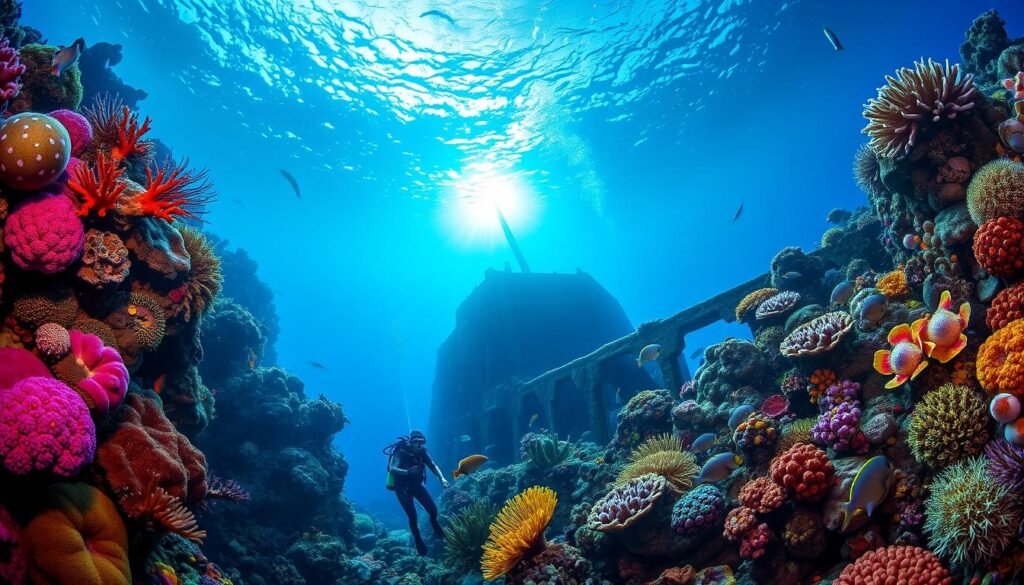
“The Caribbean is a treasure trove of wreck diving adventures, offering a glimpse into the region’s rich history and vibrant marine ecosystems.” – John Doe, Dive Magazine
USS Oriskany, Florida, USA
The “Great Carrier Reef”
The USS Oriskany was once a mighty aircraft carrier. In 2006, it was sunk off Florida to create the world’s largest artificial reef. It’s now known as the “Great Carrier Reef.”
This dive experience combines history, engineering, and nature in a big way.
Depth and Experience Requirements
The wreck starts at 24 meters and goes over 60 meters deep. It’s for advanced and technical divers. My first dive was exciting and nerve-wracking.
Be comfortable with your gear and buoyancy. You might need mixed gases for the deeper parts.
Exploring the Vast Structure
Diving an aircraft carrier is like diving a small city. The flight deck, elevator shafts, and hangar bays are huge. I imagined fighter jets ready for takeoff.
Now, fish and coral have taken their place. The ship’s massive size is humbling. Visibility and currents can vary, so plan your dive.
Marine Life and Artificial Reef Success
The Oriskany has attracted a lot of marine life. Coral and sponges are colonizing the surfaces. On my dive, I saw barracudas and schools of jacks.
The ship’s vertical structures provide diverse habitats. It’s amazing to see this transformation.
Tips for Tackling the Oriskany
If you’re not advanced certified or comfortable with deeper dives, consider a specialty course first. Nitrox is a good idea, too, since it can extend your bottom time at these depths. Definitely follow a guide who knows the wreck. It’s huge, and you can easily waste time just figuring out where to go.
Plan your dive carefully—depth, time, and gas management are critical. I learned the hard way that you can’t just wander around aimlessly. Stick to a plan, know your limits, and enjoy the ride.
After surfacing from the Oriskany, I felt like I’d visited a piece of modern history turned underwater metropolis. It’s a truly unique experience that reminds us how we can repurpose human-made structures to benefit marine ecosystems. If you’re up for the challenge and have the right skills, the Oriskany should be on your bucket list. Trust me, you’ll come back grinning and ready to tell everyone about the time you dove an aircraft carrier.
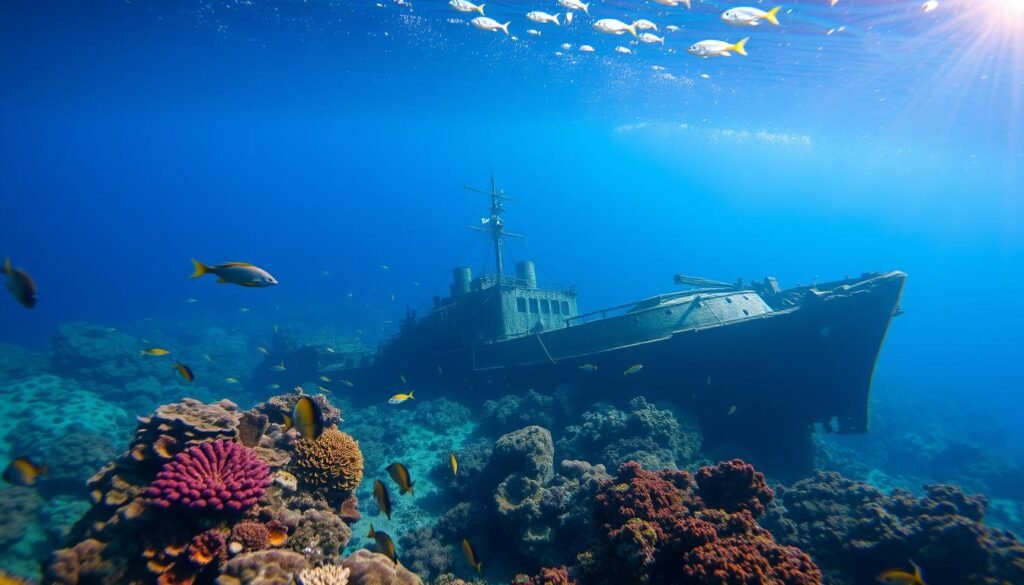
Conclusion of wreck diving sites
Wreck diving isn’t just about staring at rusted hulls and twisted metal. It’s about immersing yourself in a world where history meets marine life, where tragedy transforms into vibrant ecosystems teeming with fish, coral, and endless surprises. From the WWII-era SS Thistlegorm to the modern-day artificial reef USS Oriskany, each wreck offers its own blend of stories and underwater beauty.
The best part is that you can choose your adventure based on your skill level, interests, and comfort with depth. But remember, these sites demand respect. They hold cultural and historical significance, and often come with environmental responsibilities. Dive safely, follow guidelines, and never remove artifacts or disturb the marine life.
Think of these dives as both adventures and lessons rolled into one, giving you a glimpse into our past while celebrating the creativity of nature in adapting these metal giants.
Now, it’s time for you to chime in! Have you explored any of these wrecks, or maybe you’ve discovered a hidden gem not on this list? Share your experiences, tips, or hilarious mishaps in the comments below. By swapping stories, we can all learn, grow, and maybe even find inspiration for our next big dive. Safe bubbles, my friends, and happy exploring!
FAQ
What certification level do I need to safely dive on these famous wrecks?
The certification needed varies by wreck. For example, the Hilma Hooker or RMS Rhone are at moderate depths. They’re good for intermediate divers with strong buoyancy skills.
However, wrecks like the USS President Coolidge or USS Oriskany need advanced or technical certifications. This is due to their depth and complexity. Always check with a trusted dive operator and be honest about your abilities.
How do I choose a wreck dive that’s right for me?
Consider your skill level, experience, and interests. Beginners might start with a shallower wreck like the Hilma Hooker. More experienced divers might aim for deeper sites like the USS President Coolidge.
Think about travel, local conditions, and which wreck’s story interests you the most. This will help you choose the right dive.
Is it safe to penetrate inside a shipwreck, or should I stick to the exterior?
Exploring inside a wreck is exciting but risky. Beginners or intermediate divers often start with the exterior. If you plan to go inside, ensure you have the right training and a guide.
Also, have a reliable light source and good buoyancy skills. Never go beyond what feels safe; safety is paramount, and there’s no shame in admiring a wreck from the outside.
Do I need special equipment for wreck diving?
You’ll need more than basic dive gear. A good dive torch is crucial for seeing in dark places. A reel and line can help navigate tight spaces.
Nitrox certification can also extend your dive time on deeper dives. Always follow local guidelines and your dive operator’s advice on gear.
How can I be a responsible and respectful wreck diver?
Treat wrecks like underwater museums. Don’t touch or remove artifacts, and avoid disturbing marine life. Keep good buoyancy to prevent kicking up silt or damaging coral.
Follow local rules, dive within your limits, and respect the history these wrecks hold. By doing this, you help preserve these sites for future divers.
